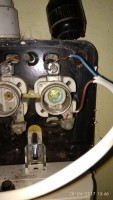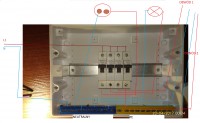Hello,
I need to connect to the old switchboard which is in the picture a new circuit. Please tell me how to connect? I do not fully understand the principle of operation. The current is on the bottom left and on the top right. I would like to connect a new fuse, where is the neutral wire? Or connect the circuit directly to the existing fuse
I know that the whole installation is to be replaced, but it is only for renovation.
Please do not suggest using a wire connected to the fuse. In combination, one works and the current flows, in the other after screwing in, the current should flow, right?
I need to connect to the old switchboard which is in the picture a new circuit. Please tell me how to connect? I do not fully understand the principle of operation. The current is on the bottom left and on the top right. I would like to connect a new fuse, where is the neutral wire? Or connect the circuit directly to the existing fuse
I know that the whole installation is to be replaced, but it is only for renovation.
Please do not suggest using a wire connected to the fuse. In combination, one works and the current flows, in the other after screwing in, the current should flow, right?





